
A Strategic Analytic Model is the non-negotiable first step in creating Strategic Intelligence, and cascades downto also enable Operational, Tactical, and Technical Intelligence.
The most relevant strategic analytic model to our purposes is the one inspired by the United Nations High Level Panel on Threats, Challenges, and Change. Their report, A More Secure World–Our Shared Responsibility–Report of the Secretary-General’s High-level Panel on Threats, Challenges and Change provides for the first time ever a prioritized list of the top ten high-level threats to humanity.
That list, in that priority, comprises the vertical aspect of the Strategic Analytic Model.
The following quote from Senator Sam Nunn (D-GA), now retired but then the Chairman of the Senate Armed Services Committee (SASC), is instructive:
I am constantly being asked for a bottom-line defense number. I don't know of any logical way to arrive at such a figure without analyzing the threat; without determining what changes in our strategy should be made in light of the changes in the threat; and then determining what force structure and weapons program we need to carry out this revised strategy.
As the matrix below will illustrate, in relation to the ten high-level threats now agreed upon by most Nations, Terrorism and Proliferation, the two that ostensibly guide existing U.S. defense “strategy,” are numbers nine and eight respectively.
First however, let us contemplate “Whole of Government” as the container for the varied “Instruments of National Power.” One short-hand approach popular in the War Colleges is the concept of DIME: Diplomatic, Informational, Military, and Economic. By no means comprehensive, this avoids a proper appreciation of both domestic constraints and needs on foreign and national security policy, and prevents consideration of both nuances, and non-state threats as well as natural threats.
Earth Intelligence Network (EIN), the 501c3 Public Charity that sponsors Phi Beta Iota, the Public Intelligence Blog, conducted a study of Mandate for Change books published by the transition teams for the varied finalists for President of the USA over the past 20 years, and identified twelve core policy areas that must be managed in harmony with one another in the context of a balanced budget, if one is to be effective in satisfying public interest expectations for both peace and prosperity. The comprise the horizontal axis of the Strategic Analytic Model, as shown below.
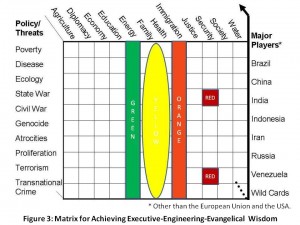
Not yet discussed are the eight demographic challenges that will assuredly determine the future of the Earth and of Humanity. NOTHING the Western powers do in the next twenty years will matter at all, with ONE exception: they can come together with African, Americas, and Asian nations and agree that the one inexhaustible resource we have on this planet is the human brain, and that the quickest way to create infinite stabilizing wealth is by a combination of empowering each of the five billion poor with free cell phone service for at least 3 years; by providing call centers able to educate and inform the poor “one cell call at a time” in each of the 183 core languages using millions of volunteers world wide; and finally, by sponsoring a totally transparent Open Source World Brain with an embedded EarthGame that connects all human minds with all information in all languages all the time time.
Learn more at 2008 Rebalancing the Instruments of National Power–Army Strategy Conference of 2008 Notes, Summary, & Article; 2000 Presidential Leadership and National Security Policy Making; 2001 Threats, Strategy, and Force Structure: An Alternative Paradigm for National Security; 1998 JFQ The Asymmetric Threat: Listening to the Debate; 1997 USIP Conference on Virtual Diplomacy Virtual Intelligence: Conflict Avoidance and Resolution through Information Peacekeeping.
All or Nothing Analysis
Bureaucracies do “stove-pipe” analysis. A crippling fact about the U.S. intelligence and defense communities is that they are coming off what one author calls a Fifty Year Wound in which “government specifications cost-plus engineering” has been justified by fraudulent threat studies, and completely disconnected from reality (for example, building 50-70 ton systems when most of the world has 10-30 ton bridge limits). At the strategic level, and remembering the importance of costing out options across all the policy spending areas and in the context of a balanced budget, it has to be all or nothing. Every threat and every policy must be evaluated in relation to all the other threats and policies. Anything less is not strategic.
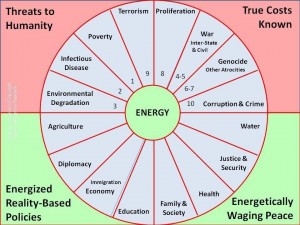
The key point here is that in Whole Systems analysis and remediation it is IMPOSSIBLE to be successful if you allow Departments and Agencies to do stove-piped analysis and stove-piped programming and budgeting. This is why the Office of Management and Budget (OMB) abdication of the “M” and its refusal to demand proper intelligence support for ALL elements of the government (not just the policy level but to the action officer level) makes OMB the most ineffective part of the Executive Office of the President (EOP) in relation to its actual mission and its national and global potential.
Levels of Analysis
Edward Luttwak's book ,Strategy: The Logic of War and Peace, Revised and Enlarged Edition is still the best available introduction to the levels of analysis and why capabilities at one level that do not make sense alone at that level, make sense in the larger context. His example: tactical assets such as man-portable anti-tank rockets create time and space opportunities for operational level assets such as artillery to be brought to bear, which in turn can be orchestrated with strategic level aviation assets.
The threat changes depending on the level of analysis.
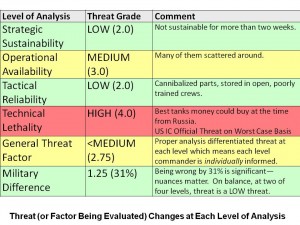
Levels of analysis are also a useful way to think about civilian, military, and natural-geographic “slices” while also understanding the differences among the levels within each slice, and establishing specific types of information most useful at each level.

Levels of Difficulty
Analysts who are not themselves combat arms specialists or engineers or diplomats need to either learn the language of the customer, or as an immediately useful intermediate step, establish in the client's own terms how the client defines “degrees of diffulty.” The Marine Corps Intelligence Center ((MCIC) did precisely this for each of the mission area factors across all the warfighting and civilian constabulary areas, and that is what made the 1990 Expeditionary Environment Analytic Model so valuable to the warfighter. Below is a simplified example of mission area degree of difficulty matrix; the graphic connects to the full model
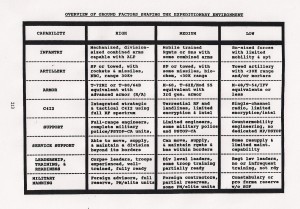
Areas of Interest
At the strategic level, Areas of Interest are those countries to be specifically included in the planning, programming, and budgeting process as being relevant to both force structure and operational planning. In the case of the original Expeditionary Factors Study, this list, agreed to by the G-2's across the entire Marine Corps, came to 67 countries and 2 island groups.
At the operational level, mis-perceptions can be avoided by being careful to specify the areas of interest in any given country. Generally this will include all coastal areas, all major population centers, key lines of communication, and specific target areas of interest. In other words, if 80% of the country is underwater, and all action will take place on the 20% that is still above water, the strategic generalizations should be based on that 20% rather than the whole.
Strategic Generalizations
At the same time that one is providing precise tactical and operational threat awareness to the client for any specific location and opponent, by virtue of having a Strategic Analytic Model it is possible to arrive at Strategic Generalizations. Below is a two-page summary for Mapping, Charting, & Geodesy (MC&G), listing countries for each region within their degree of difficulty column. Each illustrations connects to the complete 1990 report (this aspect was never repeated despite its obvious relevance to Marine Corps force structure planning. Learn more at2008 U.S. Naval Power in the 21st Century; and 1991 MCG Intelligence Support for Expeditionary Planners.
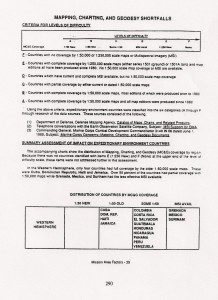

This learning segment does not address Information Operations (IO) and especially the seven levels of IO and the IO Cube; nor does it address the nuances of predicting and remediating Revolution across the political-legal, socio-economic, ideo-cultural, techno-demographic, and natural-geographic domains.
In the latter, the political science term of “operationalization” is very important–when evaluating revolutionary potential, it is vital to specify the nature of the data that must be collected, and the context within which the data will be considered to be representative of any specific degree of the condition.
Cultural intelligence and the grand array of 144 “mind” concepts remain to be studied in detail. Two books helpful here are Nonzero–The Logic of Human Destiny; and Not by Genes Alone: How Culture Transformed Human Evolution.
History is completely neglected by both the policy and the intelligence communities. The young people being spoon-fed secrets have virtually no context in either historical or cultural terms, and are also handicapped by being assigned to Weberian “cubbies” (the CIA Climate Change Center came out just in time for ClimateGate–this is a double whammy, CIA being 20 years late, *and* CIA being unable to orchestrate “Whole Earth” intelligence precisely because CIA does not *have* a Strategic Analytic Model.



